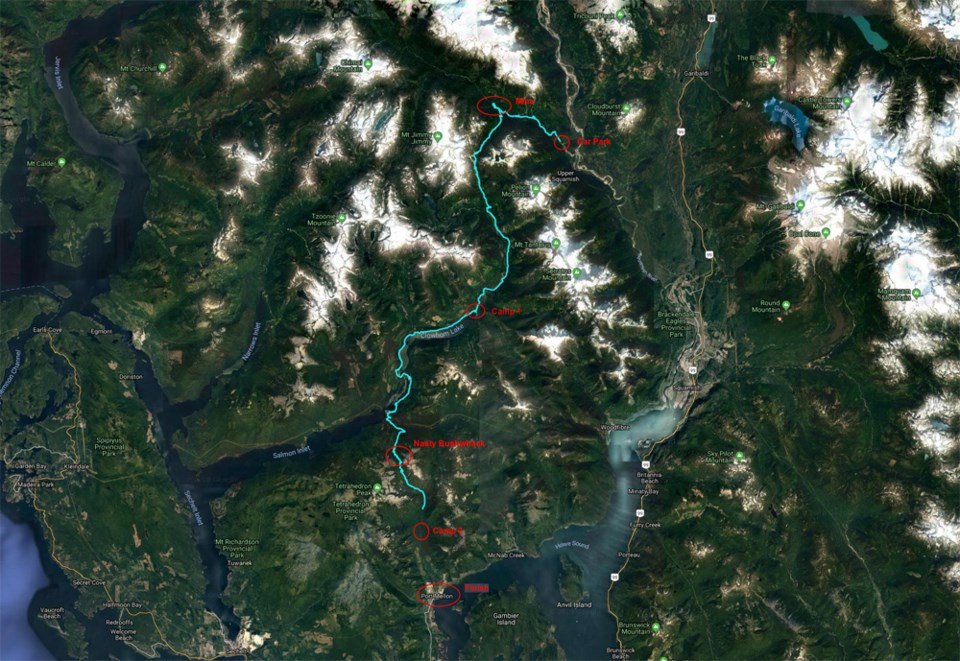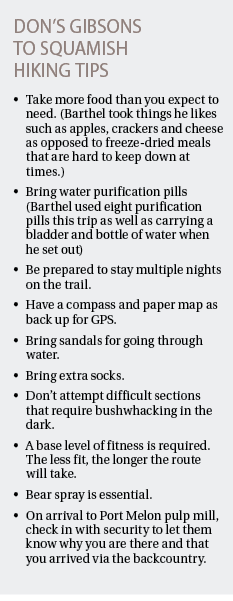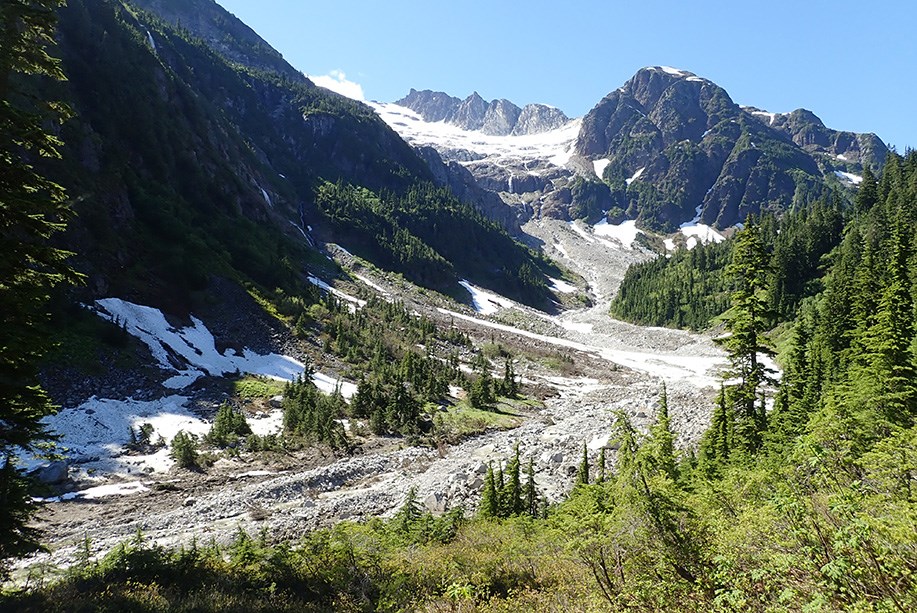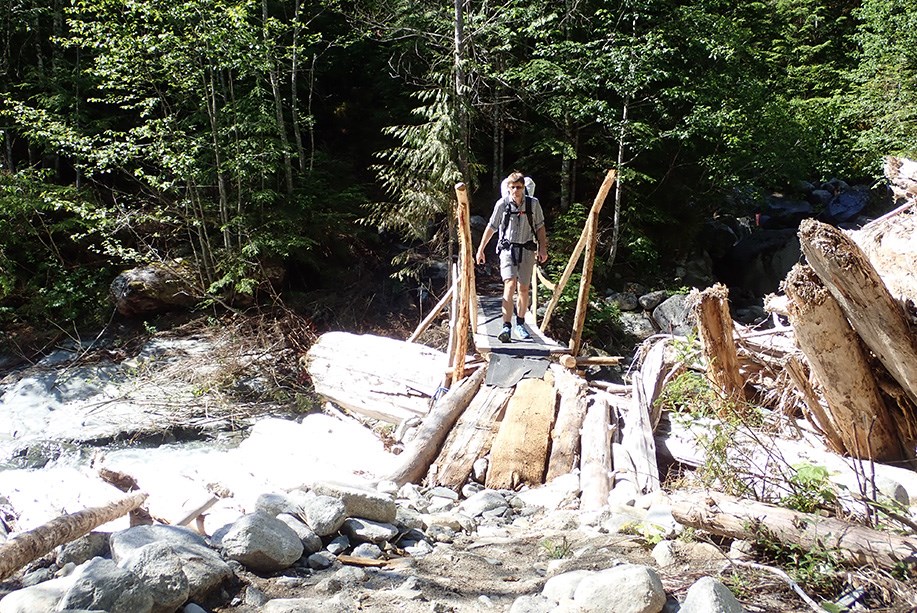Growing up in Vancouver, I had always assumed the Sunshine Coast was an island. In my mind, anything that is only accessible by boat had to be one. On further investigation, maps revealed it was firmly connected to the mainland and even had a network of logging roads crisscrossing it. A Google search brought up a fabled road link long since overgrown. Google maps satellite view revealed a possible route.
Years ago, I first set out with a friend on “disposable” bicycles; cheap second-hand clunkers we could abandon if we ran out of road. To get across the Squamish River at the end, we had a packraft. We had three days, and it was a solid plan that failed miserably.
We approached from Gibsons but quickly ran out of road after Port Mellon. We tried to take what looked from Google Maps like a possible coastal link under the power lines to McNab Creek, however, it was anything but; it quickly became cliffy, and we were forced into the steep thick forest. We carried our bikes deep into the woods before abandoning them. Each bike was left with a laminated note imploring the finder to email us and tell us what became of the bike. Only one bike was ever found. Soon it became too much on foot so we used the packraft to paddle to the McNab Creek Forest Service Road. That too turned out to be a dead end and we ended up hitchhiking out on a Spot Prawn fishing boat. It was very clear why the government had never built a road this way.
Years later, I made a successful attempt with Don Barthel this time from the Squamish side. We used a packraft to access the pipeline route that climbs up and over to Woodfibre. After rafting across the Squamish River near Squamish, our night start had us attacking most of the steep bushy slope of the pipeline in the dark. We encountered a confused deer who “led” us by staying just 20 feet in front of us for most of the climb. It was so steep, the old cables that the tractors used to winch themselves up and down the slope were still in place.
The next morning saw us at the Woodfibre LNG site. The custodian there was quite hostile, as from the water the area is very clearly marked with no trespassing signs. He could not believe we hadn’t come in by boat. Once he accepted our story, he became much more amiable. Apparently, the pipeline route is kept trim by men helicoptered in every couple years to chop down the growing trees. They never go up, only down as it is too steep. The rest of the route along the pipeline was tough, but fairly straightforward. After two nights we made it to Port Mellon — mission finally accomplished.
Fast forward a few years to a local newspaper article on a new Squamish to Sunshine Coast Trail. The newspaper and a Facebook page revealed a completely different route then we had ever used. Always ready for a challenge, Don and I set off again with a lot of research and gear under our belts.
The route up and over Pokosha Pass is sublime. It equals or surpasses any of the other hikes in the area. A plethora of waterfalls tumble down from on high as the route passes over boggy bits and meadows. Although built for mountain bikes, you would have to be a serious hardcore rider to bike up or down. We had pictured something you could pull a bob trailer over, but nothing could be farther from the truth. After the pass, mudslides have obliterated the trail and markings. This felt like true wilderness. A marmot lazily sat on a rock sunning himself as we passed. Further along, the wildflowers had also obscured the trail. Waist deep flowers made for treacherous footing down into deep gullies.

It doesn’t take too long to connect with logging roads on the other side. Although overgrown, they could easily be trimmed back to make for a fast, easy trail. From here, it is a long walk to Clowham Lake where we made camp at 10:30 p.m. We had left the trailhead at 8 a.m.; a long day exacerbated by exploration of an old mine on the other side.
We had hoped to make the trail in two days and one night, so we started early. Another few hours walking brought us to Sechelt Inlet where a relatively fresh logging cut and now deactivated road brought us to within a couple of kilometres of the Sechelt Creek Power Plant. Unable to find any trail flagging, we bushwhacked in steep terrain until cliffs pushed us low to a dead end. Only contour lines on the GPS saved us. My open maps program on my phone is relatively useless without any roads or trails of note anywhere between Pokosha Pass and the Rainy River Forest Service Road. So few people travel this way that nobody had bothered to input the data yet.

We had to retrace our steps and stay high to avoid the cliffs until we picked up flagging again on a rough, but scenic, trail through thick moss to the power station. Here once again we slogged ahead in the hot sun on logging roads gaining 600 metres to a relatively short 1.6 kilometre gap, to the Rainy River Forest Service Road. Here was the crux of the trip.
The valley deadened in cliffs 200 metres high, which in winter must get hit by constant avalanches. The resulting flattened slide alder, berry bushes, and devils club were a nightmare to bushwhack through. The tempting wide-open old growth forests generally went in the wrong direction and the easier boulder fields were occasionally so giant that they became impassable without bouldering skills and the possibility of a debilitating fall. The only “easy” way was to boulder up the stream bushwhacking around waterfalls. This brought us to the head of the valley surrounded by cliffs. At this point our GPS malfunctioned, the map and contours disappearing from the screen. Thankfully, Don had memorized the best and only seemingly viable route. Up, up, up it went as more of a tree climb than hike; our arms working as hard as our legs. Only the best trail builder could build anything here. It is the sort of trail that seems impossible even after you make it to the end. Without flagging to navigate by, we went by feel, scrambling up rocky faces on occasion dodging around cliffs. It felt untouched, with no sign of human sullying. It took five hours to do that 1.6 km. At the top, we once again picked up flagging through old growth through to Rainy River and an eventual camping spot at 10:30 at night. We had made it.
The route can only be defined as long and gruelling but with great potential. At the moment an average recreational hiker would probably take five days if she or he had the skills to route find and bushwhack through. A security guard at Port Mellon told us we were only the second people he had ever heard of to complete the route, the first being a year ago. Although untrue (we had talked to them the first time we completed it several years ago) this gives you an indication of how few people do it. It’s about time somebody built a trail to link these two places so close to Vancouver, but at the moment I wouldn’t recommend it to anyone but the hardiest and experienced adventurers.
For more about me surf to tysontravels.wordpress.com/

Editor’s note: Tyson and Don are former adventure racers and so very trained and experienced with long-distance treks. This route should not be attempted without thorough preparation and knowledge.



